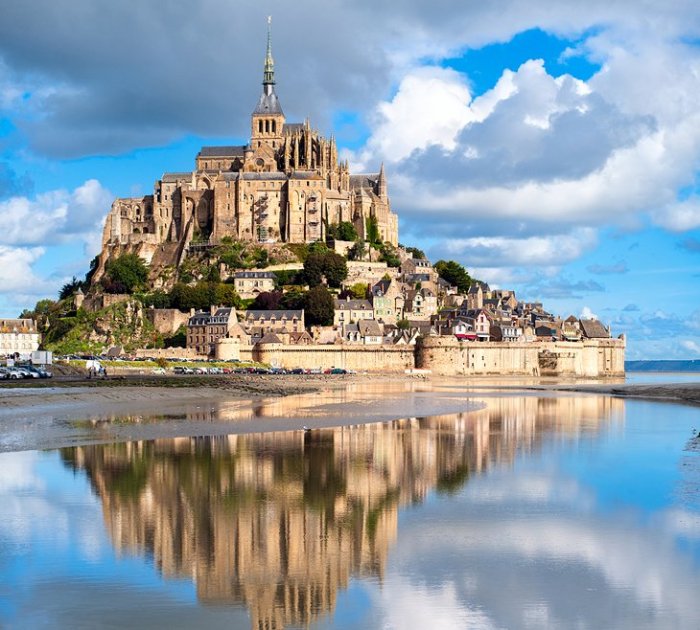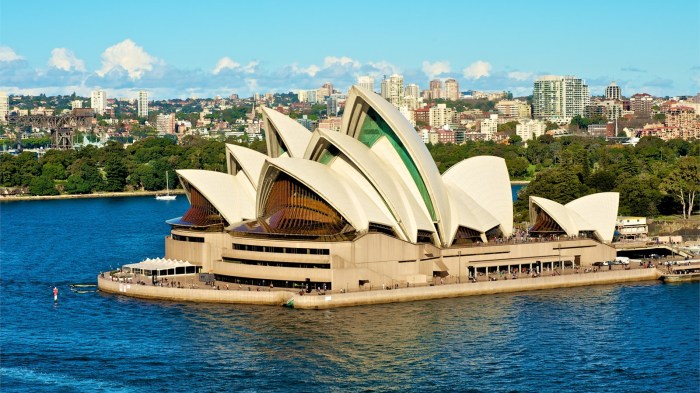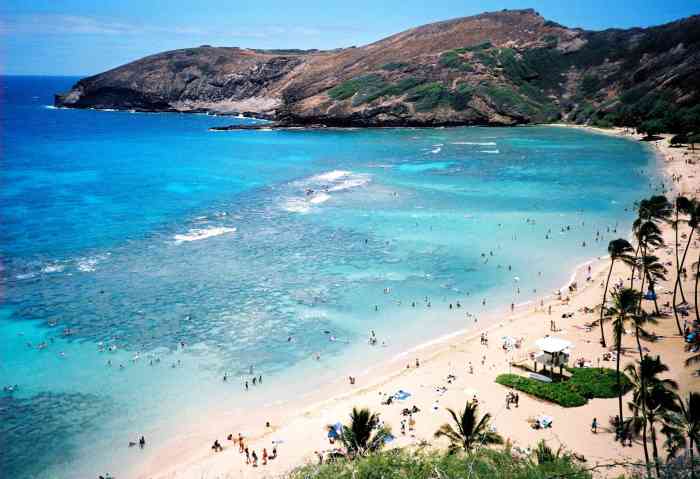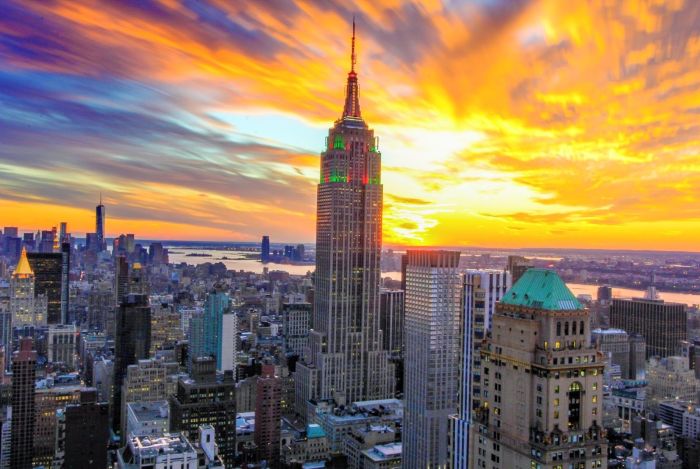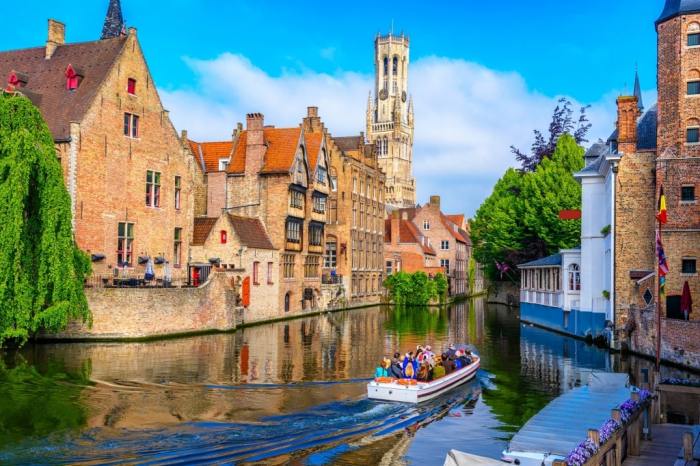Top 10 Places To Visit In Normandy
Top 10 Places To Visit in Normandy: From the dramatic cliffs of Étretat to the historical D-Day landing beaches, Normandy is a region brimming with history, culture, and natural beauty. This captivating region of France offers something for everyone, whether you’re a history buff, a foodie, an outdoor enthusiast, or simply looking for a charming escape.
From iconic landmarks like Mont Saint-Michel and the Bayeux Tapestry to quaint villages and picturesque countryside, Normandy is a destination that will leave you wanting more. Explore the historical significance of the D-Day landing beaches, marvel at the architectural wonders of Rouen Cathedral, and savor the region’s culinary delights, from fresh seafood to creamy cheeses.
Historic Sites
Normandy is a region in northwestern France that boasts a rich and fascinating history. Its historical significance is reflected in the numerous ancient sites and monuments that dot the landscape. A trip to Normandy offers a chance to step back in time and experience the events that shaped the region and the world.
Mont Saint-Michel Abbey
Mont Saint-Michel Abbey is a breathtaking Benedictine abbey perched atop a tidal island in the bay of Mont Saint-Michel. This UNESCO World Heritage Site is a marvel of architecture and engineering. The abbey’s construction began in the 8th century, and it has been expanded and modified over the centuries.
Normandy is seriously cool, with all the history and stuff. But if you’re looking for something a little more laid-back, maybe with some beaches and ancient ruins, check out the Top 10 Places To Visit in Crete. Once you’ve soaked up the sun and explored the island, you can come back to Normandy and hit up the D-Day beaches – totally worth it.
The abbey’s most notable feature is its imposing Gothic architecture, particularly the soaring spire that dominates the skyline. The abbey played a significant role in medieval French history, serving as a place of pilgrimage and a center of learning. Today, visitors can explore the abbey’s labyrinthine corridors, marvel at the breathtaking views from the ramparts, and learn about its fascinating history.
D-Day Landing Beaches
The D-Day landing beaches are a testament to the bravery and sacrifice of the Allied forces who liberated Europe from Nazi occupation during World War II. The beaches, located along the Normandy coast, were the scene of fierce fighting on June 6, 1944, as Allied troops stormed ashore under heavy German fire.
The five main landing beaches are:
- Omaha Beach: The site of the bloodiest fighting on D-Day, Omaha Beach was heavily defended by German forces. The American troops who landed here faced intense resistance and suffered heavy casualties.
- Utah Beach: The westernmost landing beach, Utah Beach was the site of the American 4th Infantry Division’s landing. The Americans met less resistance here than at Omaha Beach and were able to secure their objectives relatively quickly.
- Sword Beach: The easternmost landing beach, Sword Beach was the site of the British 3rd Infantry Division’s landing. The British faced fierce resistance from the Germans but were able to secure their objectives after several hours of fighting.
- Gold Beach: Located between Sword Beach and Juno Beach, Gold Beach was the site of the British 50th Infantry Division’s landing. The British faced less resistance here than at Sword Beach and were able to secure their objectives relatively quickly.
- Juno Beach: Located between Gold Beach and Sword Beach, Juno Beach was the site of the Canadian 3rd Infantry Division’s landing. The Canadians faced heavy resistance from the Germans but were able to secure their objectives after several hours of fighting.
Today, the D-Day landing beaches are a poignant reminder of the sacrifices made by the Allied forces who liberated Europe from Nazi occupation. Visitors can walk the beaches, visit the cemeteries and memorials, and learn about the events of D-Day.
Bayeux Tapestry
The Bayeux Tapestry is an embroidered cloth that depicts the events leading up to the Norman Conquest of England in 1066. The tapestry, which is over 230 feet long, is considered a masterpiece of medieval art and a valuable historical document.
The tapestry was likely commissioned by Bishop Odo of Bayeux, a half-brother of William the Conqueror. It was created in the 11th century and is now housed in the Bayeux Museum.The Bayeux Tapestry is a fascinating glimpse into medieval life and culture.
It depicts scenes of battles, feasts, and everyday life in 11th-century England and Normandy. The tapestry is also a valuable source of historical information about the Norman Conquest. It provides a visual record of the events that led to the conquest, including the Battle of Hastings, which was a decisive victory for William the Conqueror.
Charming Towns and Villages
Normandy is not just about historical sites; it also boasts a collection of charming towns and villages that offer a glimpse into the region’s rich culture and picturesque landscapes. Each town possesses its unique character, from the artistic haven of Honfleur to the historical heart of Rouen, making them essential stops on any Normandy itinerary.
Honfleur
Honfleur is a captivating town nestled on the Normandy coast, renowned for its charming harbor and artistic heritage. Its picturesque harbor, lined with colorful houses and boats bobbing gently on the water, creates a scene straight out of a postcard.
The town’s artistic heritage is evident in its numerous art galleries and museums, showcasing works by renowned Impressionist painters who were drawn to the beauty of Honfleur’s light and landscapes. One of the most notable examples is the Musée Eugène Boudin, dedicated to the famous Impressionist painter who captured the essence of Honfleur in his works.
Rouen
Rouen, the historical capital of Normandy, is a city steeped in history and culture. Its iconic cathedral, Notre-Dame de Rouen, is a masterpiece of Gothic architecture and a testament to the city’s rich past. The cathedral served as a backdrop for Claude Monet’s famous series of paintings, capturing the ever-changing play of light on its facade.
Rouen also played a significant role in the Hundred Years’ War, serving as the site of Joan of Arc’s trial and execution. Visitors can explore the historical sites related to Joan of Arc, including the Place du Vieux-Marché, where she was burned at the stake, and the Église Sainte-Jeanne-d’Arc, built on the site of her prison.
Normandy’s rich history and stunning landscapes are definitely worth exploring, and you can’t go wrong with a trip to Mont Saint-Michel or the D-Day beaches. If you’re looking for a completely different vibe, though, maybe consider checking out the Top 10 Places To Visit in New Zealand.
New Zealand offers breathtaking scenery, incredible hiking, and a totally different cultural experience. After all, it’s hard to beat exploring the beauty of the South Island’s fjords or the North Island’s geothermal wonders!
Bayeux
Bayeux is a charming medieval town known for its stunning architecture and vibrant market. The town’s most famous landmark is the Bayeux Tapestry, an embroidered cloth depicting the Norman Conquest of England. The tapestry is housed in the Musée de la Tapisserie de Bayeux, a museum dedicated to the history and significance of this remarkable piece of art.
Normandy is packed with history, from the beaches of D-Day to the majestic Mont Saint-Michel. But if you’re looking for a totally different kind of adventure, maybe you should check out the Top 10 Places To Visit in Tanzania – you can see amazing wildlife, climb Mount Kilimanjaro, or just relax on the beaches of Zanzibar.
After all, there’s no shortage of awesome places to explore in the world, and Normandy is just one stop on a long list of destinations.
Beyond the tapestry, Bayeux offers a delightful blend of medieval charm and modern life. Its cobbled streets are lined with half-timbered houses, quaint shops, and charming cafes, inviting visitors to explore its historic heart. The town’s vibrant market, held every Tuesday and Friday, is a feast for the senses, showcasing local produce, crafts, and regional specialties.
Natural Wonders
Normandy’s natural beauty is as captivating as its history. From towering cliffs to rolling hills, the region offers a stunning array of landscapes that will leave you breathless.
The Cliffs of Étretat
The white chalk cliffs of Étretat are a breathtaking sight. These dramatic formations rise high above the English Channel, sculpted by wind and waves into unique and awe-inspiring shapes. The most famous of these formations is the “Needle” (l’Aiguille), a tall, slender spire that stands proudly against the sky.
The cliffs are a popular spot for hiking, rock climbing, and simply enjoying the stunning views.
The Normandy Countryside
The Normandy countryside is a patchwork of rolling hills, lush meadows, and apple orchards. The region is known for its picturesque villages, charming farms, and quiet lanes. The countryside is a haven for nature lovers, offering opportunities for hiking, cycling, and horseback riding.
The region is also home to a variety of wildlife, including deer, foxes, and birds.
The D-Day Landing Beaches
The D-Day Landing Beaches are a poignant reminder of the sacrifices made during World War II. These beaches, located along the Normandy coast, were the site of the Allied invasion of France on June 6, 1944. The beaches are now a memorial to the soldiers who fought and died on that fateful day.
Today, visitors can explore the beaches and learn about the history of the D-Day landings.
Museums and Cultural Experiences
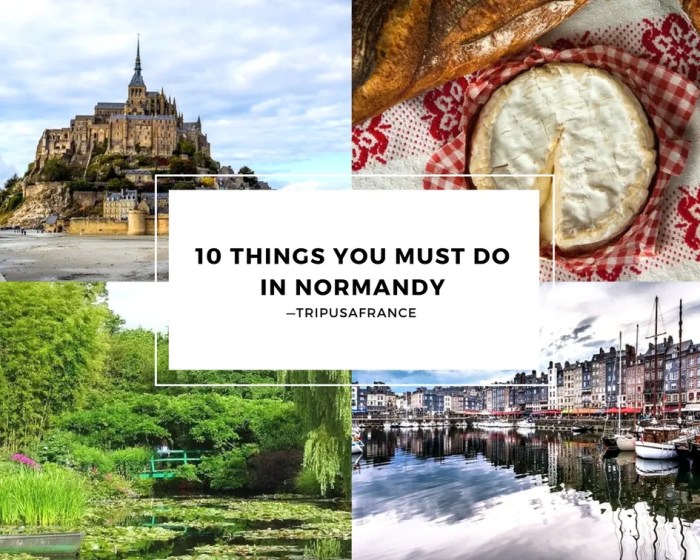
Normandy’s rich history and culture are beautifully preserved in its many museums, offering a glimpse into the region’s past and present. From world-renowned memorials to charming local galleries, Normandy provides a diverse range of cultural experiences for every visitor.
Top Museums in Normandy
Normandy boasts an impressive collection of museums, each offering a unique perspective on the region’s history, art, and culture. Here are some of the must-visit museums:
- Caen Memorial:This poignant museum commemorates the events of World War II, focusing on the Normandy landings and the subsequent liberation of France. Visitors can explore exhibits detailing the war’s impact on the region and the lives of those involved. The museum also features a vast collection of artifacts, photographs, and personal accounts, offering a powerful and moving experience.
- Bayeux Museum:Housing the famous Bayeux Tapestry, this museum provides a fascinating glimpse into the Norman Conquest of England in 1066. The tapestry, a 70-meter-long embroidered cloth, depicts the events leading up to the Battle of Hastings, offering a unique historical perspective.
The museum also features other exhibits related to the Norman period, including artifacts, sculptures, and paintings.
- Rouen Fine Arts Museum:Located in the heart of Rouen, this museum houses a diverse collection of paintings, sculptures, and decorative arts spanning from the Middle Ages to the present day. Visitors can admire works by renowned artists such as Claude Monet, Eugène Boudin, and Pierre-Auguste Renoir, offering a journey through the evolution of French art.
Cultural Offerings of Normandy
Normandy is renowned for its rich cultural heritage, evident in its traditional cuisine, music, and art.
Cuisine
Normandy’s culinary scene is characterized by its emphasis on fresh, local ingredients. The region is famous for its dairy products, including creamy Camembert and Livarot cheeses, as well as its apple cider and Calvados brandy. Seafood is also a staple, with dishes like moules marinières (mussels in white wine) and fish stew being popular choices.
Music
Normandy has a vibrant music scene, with traditional folk music playing a significant role in the region’s cultural identity. The region is known for its lively festivals, where local musicians perform traditional songs and dances, often accompanied by instruments like the accordion and the fiddle.
Art
Normandy’s art scene is diverse and thriving, with influences from various periods and styles. The region is particularly known for its Impressionist art, inspired by the region’s beautiful landscapes and coastal scenery. Renowned artists like Claude Monet, Eugène Boudin, and Gustave Courbet captured the essence of Normandy in their paintings, showcasing the region’s picturesque beauty.
Top Cultural Events in Normandy
Normandy hosts a variety of cultural events throughout the year, offering a chance to experience the region’s vibrant arts scene and traditions. Here are some of the most notable events:
| Event | Date | Description |
|---|---|---|
| D-Day commemorations | June 6th | A series of events held annually to commemorate the Normandy landings, including parades, ceremonies, and historical reenactments. |
| Festival du film américain de Deauville | September | A renowned film festival showcasing American cinema, featuring screenings, awards ceremonies, and red carpet events. |
| Festival de musique de Bayeux | July | A popular music festival featuring a diverse range of genres, from classical to jazz to contemporary music. |
| Festival du cheval de la Manche | August | A celebration of equestrian culture, featuring horse shows, competitions, and demonstrations. |
Foodie Delights
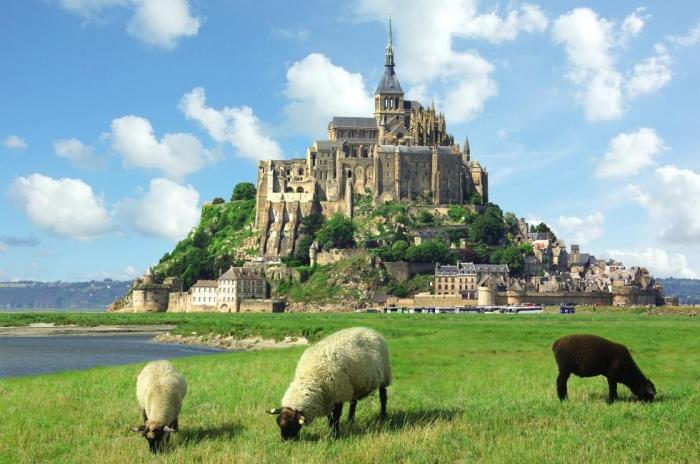
Normandy’s culinary scene is a delightful journey for your taste buds, offering a unique blend of fresh, local ingredients and traditional recipes. From the bounty of the sea to the verdant pastures, Normandy’s food reflects the region’s rich history and natural beauty.
A Taste of Normandy: A Culinary Menu
The flavors of Normandy are a testament to the region’s bounty. Here is a sample menu showcasing some of the regional specialties:
- Seafood:
- Moules Marinières (Mussels in White Wine Sauce): A classic French dish, Normandy’s mussels are known for their fresh, briny flavor.
- Sole Meunière (Pan-Fried Sole): This delicate fish is pan-fried with butter and lemon, showcasing its natural sweetness.
- Crème de la Mer (Seafood Chowder): A hearty and flavorful soup featuring a variety of fresh seafood, including cod, mussels, and shrimp.
- Cider:
- Cidre Brut (Dry Cider): A crisp and refreshing cider with a dry finish, perfect for pairing with seafood.
- Cidre Doux (Sweet Cider): A sweeter cider with a mellow flavor, ideal for sipping on its own or pairing with desserts.
- Calvados: A strong apple brandy made from fermented cider, often enjoyed after a meal.
- Cheese:
- Camembert: A soft, creamy cheese with a distinctive aroma and a rich, buttery flavor.
- Livarot: A washed-rind cheese with a strong, pungent flavor and a distinctive orange rind.
- Pont-l’Évêque: A soft, buttery cheese with a mild, slightly tangy flavor.
- Other Specialties:
- Andouille de Vire: A smoked sausage made from pork and spices, often served with cider.
- Tarte Tatin: A classic French dessert with caramelized apples and a flaky pastry crust.
- Crêpes: Thin pancakes that can be filled with sweet or savory ingredients, a popular street food in Normandy.
Culinary Traditions: A Focus on Fresh, Local Ingredients
Normandy’s culinary traditions are deeply rooted in the region’s fertile land and coastline. The emphasis is on using fresh, seasonal ingredients, sourced locally whenever possible. This dedication to quality and freshness is reflected in the region’s cuisine, which is known for its simple yet flavorful dishes.
“The food in Normandy is a celebration of the region’s bounty. It’s all about using fresh, local ingredients to create simple, delicious dishes.”
Top Restaurants in Normandy
Normandy is home to a diverse range of restaurants, offering a variety of culinary experiences. Here is a table highlighting some of the top restaurants in the region:
| Restaurant Name | Cuisine | Location |
|---|---|---|
| La Mère Poulard | French | Bayeux |
| Le Ruban Bleu | Seafood | Honfleur |
| Le Coq Hardi | French | Deauville |
| L’Auberge de la Source | French | Rouen |
| Le Pré aux Moines | French | Le Havre |
Outdoor Adventures
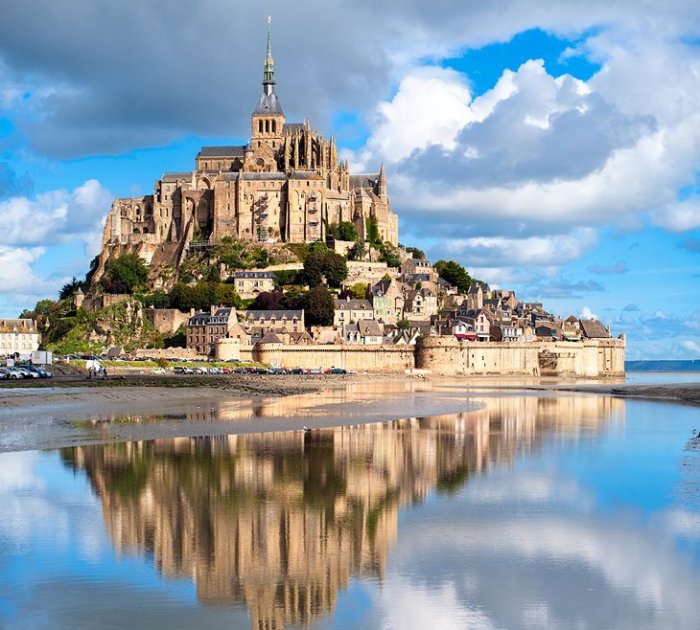
Normandy is not just about history and culture; it’s also a paradise for outdoor enthusiasts. The region’s diverse landscapes offer an abundance of opportunities to explore nature, get active, and create lasting memories.
Hiking Trails
Hiking trails in Normandy are a great way to immerse yourself in the region’s natural beauty and historical significance. From rolling hills and verdant meadows to rugged coastlines and dense forests, Normandy offers something for every hiker.
- The GR223is a popular long-distance trail that winds its way through the heart of Normandy. It passes through charming villages, historic sites, and picturesque landscapes, offering stunning views of the countryside.
- The Sentier des Douaniers(Customs Officers’ Trail) follows the dramatic cliffs of the Normandy coast, offering breathtaking views of the English Channel. It’s a challenging but rewarding hike that allows you to experience the raw beauty of the coastline.
- The Mont Saint-Michel Trailis a circular trail that leads to the iconic Mont Saint-Michel abbey, a UNESCO World Heritage site. It offers panoramic views of the bay and the abbey, making it a popular choice for hikers of all levels.
Cycling Routes
Cycling is another great way to explore Normandy at your own pace. The region’s well-maintained cycling paths and scenic routes allow you to discover hidden gems and enjoy the tranquility of the countryside.
- The Vélo Francetteis a 450-kilometer (280-mile) cycling route that traverses Normandy from east to west. It passes through historic towns, rolling hills, and picturesque villages, offering a diverse cycling experience.
- The Normandy Coast Cycle Routeis a 600-kilometer (373-mile) route that follows the coastline from Le Havre to Cherbourg. It offers breathtaking views of the English Channel, charming seaside towns, and historical sites.
- The Pays d’Auge Cycle Routeis a 150-kilometer (93-mile) route that winds its way through the picturesque apple-growing region of Pays d’Auge. It’s a relatively flat route that’s perfect for leisurely cycling and enjoying the region’s charming villages and cider houses.
Water Sports
Normandy’s coastline and rivers offer ample opportunities for water sports enthusiasts. Whether you prefer sailing, kayaking, or surfing, you’ll find plenty of options to get your adrenaline pumping.
- Sailingis a popular activity in Normandy, with numerous sailing schools and charter companies offering lessons and excursions. The region’s sheltered bays and calm waters provide ideal conditions for beginners and experienced sailors alike.
- Kayakingis another great way to explore Normandy’s coastline and rivers. You can rent kayaks at various locations and paddle along the coast, explore the estuaries, or navigate the tranquil rivers.
- Surfingis becoming increasingly popular in Normandy, with several surf schools offering lessons and rentals. The region’s Atlantic coast offers some excellent waves for both beginners and experienced surfers.
Family-Friendly Activities
Normandy is a fantastic destination for families, offering a mix of historical attractions, natural wonders, and kid-friendly activities. From amusement parks and zoos to historical reenactments and interactive museums, there’s something for everyone to enjoy.
Kid-Friendly Attractions
Normandy boasts a range of attractions designed to entertain and educate young visitors.
- Parc Zoologique de Cerza: Located in Le Mesnil-Villey, this zoo houses over 1,000 animals from around the world. Kids will love seeing lions, tigers, bears, and more, as well as participating in interactive exhibits and educational programs.
- Le Manoir des Pirates: This amusement park in Saint-Pair-sur-Mer offers a fun-filled day for families with rides, games, and pirate-themed attractions. Kids can explore a pirate ship, ride a carousel, and enjoy a variety of shows and performances.
- The D-Day Landing Beaches: While the beaches are historically significant, they also offer opportunities for family-friendly activities. Kids can explore the beaches, visit museums, and learn about the history of World War II. The American Cemetery and Memorial in Colleville-sur-Mer is a poignant and educational experience for all ages.
- The Bayeux Tapestry: This famous tapestry, located in the Bayeux Museum, tells the story of the Norman Conquest of England. It’s a fascinating and educational experience for children, with colorful images and intricate details that bring history to life.
- Mont Saint-Michel: This iconic abbey, located on a tidal island, is a must-see for any family visiting Normandy. Kids can explore the abbey, wander the village, and enjoy the stunning views of the bay.
Family-Friendly Itinerary
A weekend trip to Normandy can be tailored to fit a family’s interests. Here’s a possible itinerary:
- Day 1: Arrive in Caen and check into your hotel. Visit the Memorial de Caen, a museum dedicated to the history of the 20th century, with exhibits that are engaging for both adults and children. In the afternoon, explore the city center, stopping by the Château de Caen, a medieval castle with a rich history.
- Day 2: Take a day trip to the D-Day Landing Beaches. Visit Omaha Beach, Utah Beach, and the American Cemetery and Memorial. Enjoy a picnic lunch on the beach and learn about the historical significance of this region. In the evening, dine in a local restaurant and enjoy traditional Norman cuisine.
- Day 3: Explore the picturesque town of Bayeux and visit the Bayeux Tapestry. Afterward, head to Mont Saint-Michel, where you can explore the abbey, wander the village, and enjoy the stunning views of the bay. In the evening, enjoy a final meal in Normandy before heading home.
Educational Experiences
Normandy offers numerous opportunities for educational experiences, combining history, culture, and interactive learning.
- Historical Reenactments: Many historical sites in Normandy host reenactments, bringing history to life for children. These events allow kids to experience firsthand what life was like during World War II, the Norman Conquest, and other significant historical periods.
- Museum Tours: Normandy has a wealth of museums, including the Memorial de Caen, the Bayeux Museum, and the D-Day Museum. These museums offer interactive exhibits, educational programs, and guided tours that cater to different age groups.
- Outdoor Activities: Normandy’s natural beauty provides a unique learning environment. Families can explore the coastline, hike through forests, and learn about the region’s diverse flora and fauna. The Normandy American Cemetery and Memorial offers guided tours and educational programs that highlight the sacrifices made during World War II.
Accommodation Options
Normandy offers a diverse range of accommodation options to suit every taste and budget, from luxurious hotels to charming bed and breakfasts. Whether you’re seeking a romantic getaway, a family adventure, or a budget-friendly stay, you’ll find the perfect place to rest your head in this beautiful region.
Top Hotels in Normandy
The region boasts a variety of top-rated hotels, catering to different preferences and budgets. Here are some noteworthy options:
- Luxury:
- Le Grand Hotel du Lion d’Or, Bayeux (Price: $$$$):Located in the heart of Bayeux, this historic hotel offers luxurious accommodations, a Michelin-starred restaurant, and a spa. The hotel features beautifully decorated rooms with antique furniture, and its prime location allows easy access to the Bayeux Tapestry and other attractions.
- La Ferme de la Guyonnière, Deauville (Price: $$$$):This charming hotel in Deauville is known for its elegant rooms, Michelin-starred restaurant, and stunning views of the English Channel. It offers a peaceful retreat with a spa and a heated indoor pool.
- Le Manoir de la Butte, Honfleur (Price: $$$$):Nestled in a picturesque setting overlooking the harbor, this hotel provides a luxurious experience with its refined rooms, gourmet restaurant, and breathtaking views.
- Mid-Range:
- Hotel du Château, Caen (Price: $$$):Situated near the historic Château de Caen, this hotel offers comfortable accommodations, a restaurant, and a bar. The hotel is known for its friendly staff and convenient location.
- Hôtel Le Lion d’Or, Rouen (Price: $$$):This charming hotel in Rouen offers comfortable rooms, a restaurant, and a bar. It is located near the historic city center, providing easy access to attractions like the Rouen Cathedral and the Gros-Horloge.
- Hotel Les Roches, Etretat (Price: $$$):This hotel offers breathtaking views of the famous Etretat cliffs and comfortable accommodations. It is a great choice for those looking to explore the stunning coastline.
- Budget-Friendly:
- Hôtel La Licorne, Bayeux (Price: $$):This hotel provides basic but comfortable accommodations in the heart of Bayeux. It offers a friendly atmosphere and a convenient location near the Bayeux Tapestry and other attractions.
- Hôtel de la Plage, Deauville (Price: $$):This hotel offers simple but clean rooms with views of the beach. It is a great choice for those looking for a budget-friendly option in Deauville.
- Hôtel de la Gare, Caen (Price: $$):Located near the train station, this hotel provides comfortable accommodations at an affordable price. It is a good choice for travelers who want easy access to transportation.
Alternative Accommodation Options
Beyond hotels, Normandy offers a variety of alternative accommodation options, including:
- Bed and Breakfasts:For a more intimate and personalized experience, consider staying at a charming bed and breakfast. These establishments offer comfortable rooms, delicious breakfasts, and a chance to interact with locals.
- Guesthouses:Guesthouses provide a more relaxed and informal atmosphere than hotels. They often offer shared common areas, such as kitchens and living rooms, making them a great choice for travelers who want to socialize with other guests.
- Holiday Rentals:For larger groups or families, holiday rentals provide a more spacious and independent option. These can range from apartments to cottages and villas, offering fully equipped kitchens and private living spaces.
Finding the Best Accommodation Deals
To find the best deals on accommodation in Normandy, consider these tips:
- Book in Advance:Especially during peak season, booking your accommodation in advance can help you secure the best rates and availability.
- Use Booking Websites:Popular booking websites like Booking.com, Expedia, and Airbnb offer a wide selection of accommodations and allow you to compare prices and reviews.
- Travel Agencies:For personalized assistance, consider contacting a travel agency specializing in Normandy. They can help you find the best accommodation options based on your preferences and budget.
- Off-Season Travel:Traveling during the off-season, typically from November to March, can result in significant savings on accommodation.
Getting Around
Normandy is a relatively small region, making it easy to explore in a short amount of time. However, the best way to get around depends on your travel style and budget. Whether you prefer the freedom of a car or the convenience of public transport, there are many options to help you discover Normandy’s treasures.
Car Rental
Renting a car is the most popular and flexible way to explore Normandy. It allows you to set your own pace and visit places not easily accessible by public transport. The region has a well-maintained road network, making it easy to navigate between towns and attractions.
Tips for Navigating Normandy by Car
- Road Conditions:Normandy’s roads are generally in good condition, with well-maintained highways and country roads. However, be prepared for narrow roads and roundabouts, especially in rural areas.
- Parking:Parking is readily available in most towns and villages, but it can be challenging to find a spot during peak tourist season, especially in popular destinations. Consider using paid parking garages or searching for street parking outside of busy areas.
- Traffic:Traffic can be heavy during peak tourist season, especially on weekends and holidays. Plan your route in advance and consider using alternative routes or traveling during off-peak hours to avoid congestion.
- Speed Limits:Speed limits are generally 50 km/h (31 mph) in towns and villages, 80 km/h (50 mph) on country roads, and 130 km/h (81 mph) on highways. Be aware of speed limits and adhere to them to avoid fines.
Public Transport, Top 10 Places To Visit in Normandy
Public transport in Normandy is generally reliable and efficient, especially for getting between major cities and towns. The region has a well-developed bus network, as well as regional train lines that connect major cities like Caen, Rouen, and Cherbourg.
Tips for Navigating Normandy by Public Transport
- Schedules and Routes:Plan your routes in advance using online resources like the SNCF website for train schedules and the Bus Normandie website for bus schedules.
- Tickets and Passes:Purchase tickets in advance, especially for train travel, as prices can vary depending on the time of day and route. Consider purchasing a regional pass for unlimited travel on buses and trains if you plan on doing extensive travel.
- Frequency:Public transport is generally more frequent in major cities and towns. In rural areas, bus services may be less frequent, so plan your travel accordingly.
Guided Tours
Guided tours offer a convenient and informative way to explore Normandy, especially for those who want to learn more about its history and culture. There are various types of guided tours available, including day trips from Paris, multi-day tours covering different regions, and specialized tours focusing on specific interests, such as World War II history or gastronomy.
Tips for Choosing a Guided Tour
- Tour Operator:Choose a reputable tour operator with good reviews and a focus on quality.
- Tour Type:Consider the type of tour that best suits your interests and travel style, whether it’s a day trip, multi-day tour, or a specialized tour.
- Tour Itinerary:Review the tour itinerary carefully to ensure it includes the attractions you want to see.
- Tour Guide:Look for tours with knowledgeable and experienced guides who can provide insights and stories about the region.
Travel Apps and Websites
Several travel apps and websites can help you plan your trip to Normandy, including:
- Google Maps:For navigating the region, finding places of interest, and getting directions.
- Rome2rio:For finding transportation options between destinations, including buses, trains, and ferries.
- TripAdvisor:For finding reviews and recommendations for restaurants, hotels, and attractions.
- SNCF:For booking train tickets and checking train schedules.
- Bus Normandie:For checking bus schedules and routes.
Beyond the Top 10: Top 10 Places To Visit In Normandy
Normandy is a region brimming with history, culture, and natural beauty, offering more than just the well-trodden tourist paths. Beyond the iconic landmarks, Normandy holds a treasure trove of hidden gems and off-the-beaten-path attractions waiting to be discovered.
Exploring Hidden Gems
Normandy’s charm lies in its lesser-known destinations, where authentic experiences and unexpected discoveries await.
- Honfleur:A picturesque harbor town, Honfleur offers a glimpse into Normandy’s artistic heritage. Its cobblestone streets, colorful houses, and lively harbor are a delight to explore.
- Bayeux:Home to the renowned Bayeux Tapestry, a masterpiece of embroidery depicting the Norman Conquest, Bayeux is a historical gem.
- Etretat:This coastal town boasts dramatic chalk cliffs, sculpted by the sea into stunning arches and needles.
- Mont Saint-Michel:While a popular destination, it’s worth venturing beyond the crowds to explore the surrounding area.
Unique Experiences in Normandy
Normandy offers a diverse range of experiences, from historical explorations to nature walks and cultural immersions.
- Historical Significance:Normandy’s rich history is palpable throughout the region. Visit the D-Day landing beaches, explore historic battlefields, and learn about the pivotal role Normandy played in World War II.
- Natural Beauty:Normandy’s coastline is a breathtaking spectacle, with dramatic cliffs, sandy beaches, and picturesque harbors.
- Cultural Richness:Normandy’s culture is vibrant and diverse. Explore charming villages, sample local cuisine, and discover the region’s artistic heritage.
Planning a Memorable Trip to Normandy
Planning your Normandy adventure can be as exciting as the trip itself. Consider these tips to ensure a memorable experience:
- Travel Time:Normandy is a year-round destination, with each season offering unique attractions. Spring and fall offer pleasant weather, while summer is ideal for beach activities.
- Budget:Normandy offers a range of accommodation and dining options, catering to different budgets.
- Activities:Normandy offers a variety of activities, from historical tours to outdoor adventures.
Wrap-Up
Whether you’re exploring the historical sites, strolling through charming towns, or enjoying the natural wonders of Normandy, you’ll find yourself immersed in a rich tapestry of experiences. From the grandeur of Mont Saint-Michel to the peaceful beauty of the Normandy countryside, this region offers a unique blend of history, culture, and natural beauty.
So, pack your bags, grab your camera, and get ready to experience the magic of Normandy!
Commonly Asked Questions
What is the best time to visit Normandy?
The best time to visit Normandy is during the shoulder seasons (spring and fall) when the weather is pleasant and the crowds are smaller. Summer can be crowded and hot, while winter can be chilly and rainy.
How long should I spend in Normandy?
To fully experience all that Normandy has to offer, you should plan to spend at least 5-7 days. However, if you have less time, you can still see some of the highlights in a shorter trip.
Is Normandy expensive to visit?
The cost of visiting Normandy can vary depending on your travel style and budget. However, it’s generally a more affordable destination than other popular European cities.
What are some of the best places to eat in Normandy?
Normandy is known for its delicious seafood, cider, and cheese. Some of the best places to eat in the region include La Mère Poulard in Mont Saint-Michel, Le Bistrot du Quai in Honfleur, and La Ferme de la Mère Poulard in Bayeux.
